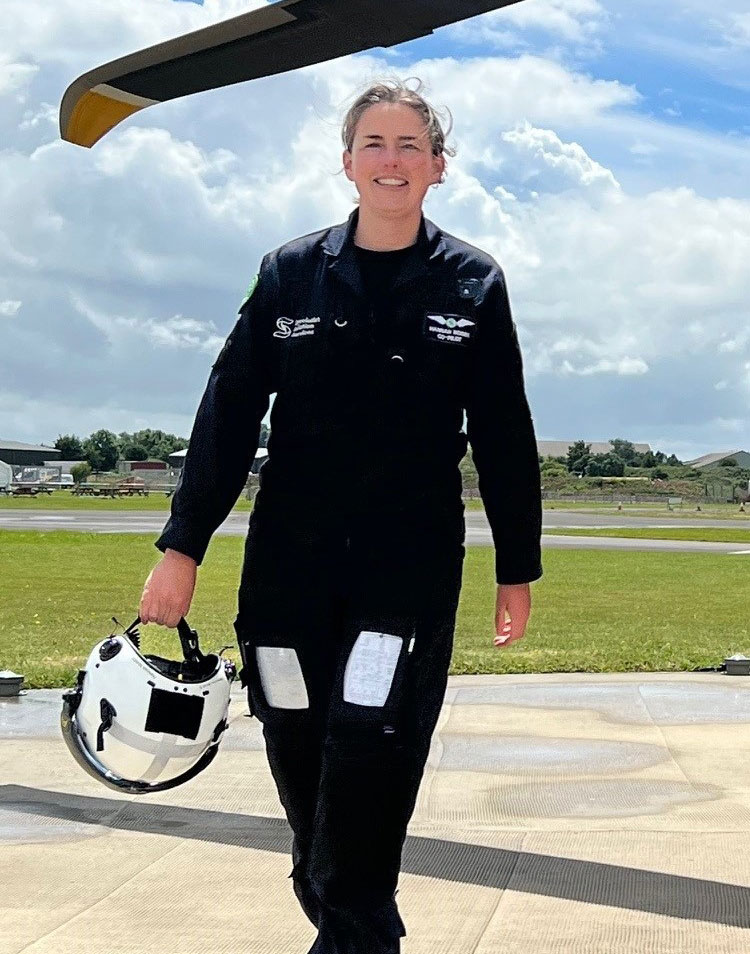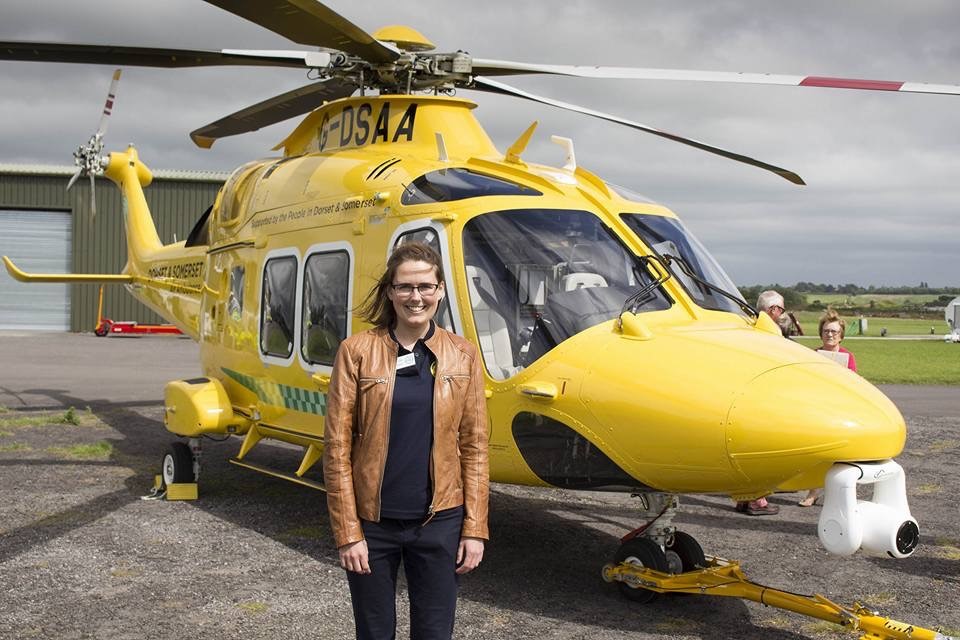I didn’t grow up wanting to fly. In fact, I started secondary school wanting to be an actress, journalist, vet and a diplomat (simultaneously!). I don’t really know where my desire to fly came from, as no family or friends were involved with aviation. I was enthused about helicopters as a teenager following a visit to The Helicopter Museum in Weston-super-Mare and this sparked my interest in helicopters which has grown ever since. A trial lesson in a small two-seat helicopter for my 16th birthday was intended to get it out of my system, but you’ve guessed it, I was hooked! More recently, I discovered that I had been given an air ambulance toy that flew over my cot, so maybe that influence was there all along.
Deciding I wanted to fly was the easy bit, while gaining the required qualification and experience to be able to fly in a Helicopter Emergency Medical Service (HEMS) role was more tricky. It was soon apparent that the military route was not an option because I wore glasses and would not pass the initial military pilot medical. The costs of training as a civilian pilot are incredibly high and I quickly realised that to fly professionally was likely to remain a dream.

During my A-levels, when presented with a list of university courses in alphabetical order, I got as far as “A” for Aerospace Engineering, which seemed as good a way as any of becoming part of the world of aviation. Four years of study later, I left the University of Southampton as an Aerospace Engineer.
It was after visiting an air show, that I first saw someone do aerobatics in a tiny helicopter. I didn’t realise at the time, but the pilot, Dennis Kenyon, would become a life-long friend and mentor who changed my life.
A tannoy announcement informed the air show crowd that the Dennis Kenyon Junior Memorial Scholarship was open for applications, for a fully funded helicopter Private Pilot’s Licence. The scholarship had been set up in memory of Dennis’s son who had tragically died in a helicopter accident. It was a long process of a written application, interview and aptitude test, but I made it through and completed my licence in the summer of 2005. This was a fantastic opportunity to be able to fly, but the cost of keeping the licence current was so high that within a few years, despite much support from friends and family, I was no longer able to fly often enough to use the licence.
It was AgustaWestland (now Leonardo) that brought me from Essex to my adopted home in the West Country. Following my graduation, I applied for a role in the helicopter preliminary design department at their site in Yeovil, the Home of British Helicopters. There, I worked on concept designs for heavy lift helicopters and tilt rotors. It was an exciting role and gave me an opportunity to work in Cascina Costa, Italy, on a brand new helicopter, known then as the “special project, XX9” which was to become the AW169, an aircraft specifically aimed at the market for HEMS.

Hannah in front of an AW169, whilst working as an engineer
There were many hours spent with HEMS professionals to develop the requirements, and several more hours with mock up models on site to try out different cabin layouts and methods of loading patients.
After the initial part of the project, I stayed in Italy to work in the rotors department as a structural analyst, developing a blade design for a tilt rotor aircraft. I then returned to Yeovil to continue with design certification analysis and testing for the AW189, which is now used by the UK Coastguard.
It was during my time working in Yeovil that I started volunteering for Dorset and Somerset Air Ambulance, giving talks to interested groups and helping at events. I became more and more interested in the charity and how it was governed. Several years later, I started serving as a trustee. I continued this role when I left Leonardo to join the Royal National Lifeboat Institution in their Innovation Team on the future life-saving programme, exploring the use of drones for Search and Rescue.
With limited opportunities to fly where I was based, I took a role with the Civil Aviation Authority (CAA) in West Sussex. The role was an exciting one – to develop regulations to enable commercial spaceflight from the UK. What it also meant, was that whilst I was working full-time, I could be near an airfield, finish chipping away at the 14 written theory exams and build the flight experience needed to start the commercial course.
During this time, (and this is the luck in timings), some air ambulances began the move from a single pilot operation, to flying with two pilots, meaning that a co-pilot role could be a possible opening into the exciting world of HEMS, if I could complete my commercial licence. But, and there is always a but, co-pilots would need an instrument rating. This is a qualification that enables pilots to fly a helicopter in cloud, only using instruments to know where they are. This course is cripplingly expensive because although 40 hours of training can be done in a simulator, a minimum of 10 hours is required in a twin turbine engine helicopter, at an average cost of about £1,400 per hour.
I now had my commercial licence and the CAA was supportive of me taking a period of unpaid leave to do the course. It was now GO BIG or GO HOME! I was delighted to be awarded a scholarship from the British Women’s Pilot Association towards the course and the rest was funded by a loan against my house and a loan from my family.
Whilst I was completing the course, Dorset and Somerset Air Ambulance advertised for co-pilots, so I applied. I was interviewed and then assessed in a simulator before finding out that all my efforts were worth it. I was offered one of the co-pilot roles, though it was conditional on me completing the instrument course, which I did. There are not many people who get the chance to fly an aircraft they have helped to develop, so as you can imagine, Peggy, our AW169 air ambulance, is extra special to me.
When people ask me what the best or most rewarding part of my job is, top of the list is always the sense of purpose from being able to help people. It’s a privilege to be a part of someone’s life and hopefully contribute to a better outcome on what could be the worst day for our patients and their families. I love working with the rest of the crew and we are a great team. I’ve learned a lot from flying with our experienced captains and I am in awe of my medical colleagues. Then there is the flying, landing and taking off from places we’ve never been to before, by day and by night. When the night is clear and we are wearing night vision goggles, it can be so beautiful and we often see shooting stars.
And, if I were to offer any advice to other women who are aspiring to working within HEMS, I would say, keep moving towards your goal, but don’t worry if it’s a longer or more winding path than you hoped; it all builds useful experience. Build your networks and talk to those who do the role you are interested in. Make the most of volunteering opportunities for air ambulance charities and always have multiple back up plans. For aspiring helicopter pilots, get very familiar with weather conditions, as most of the stressful decisions we have to make are due to the wonderfully ever-changing weather we experience in the UK.

